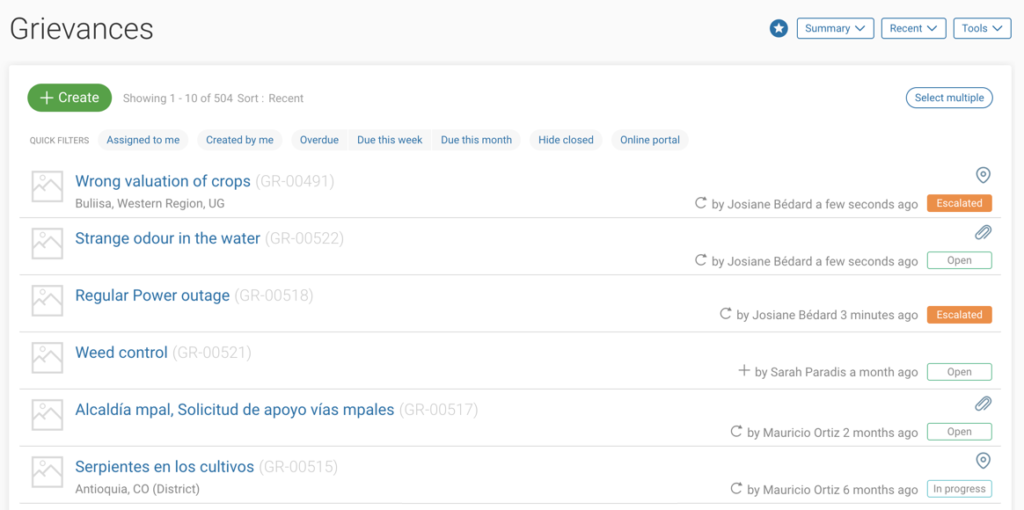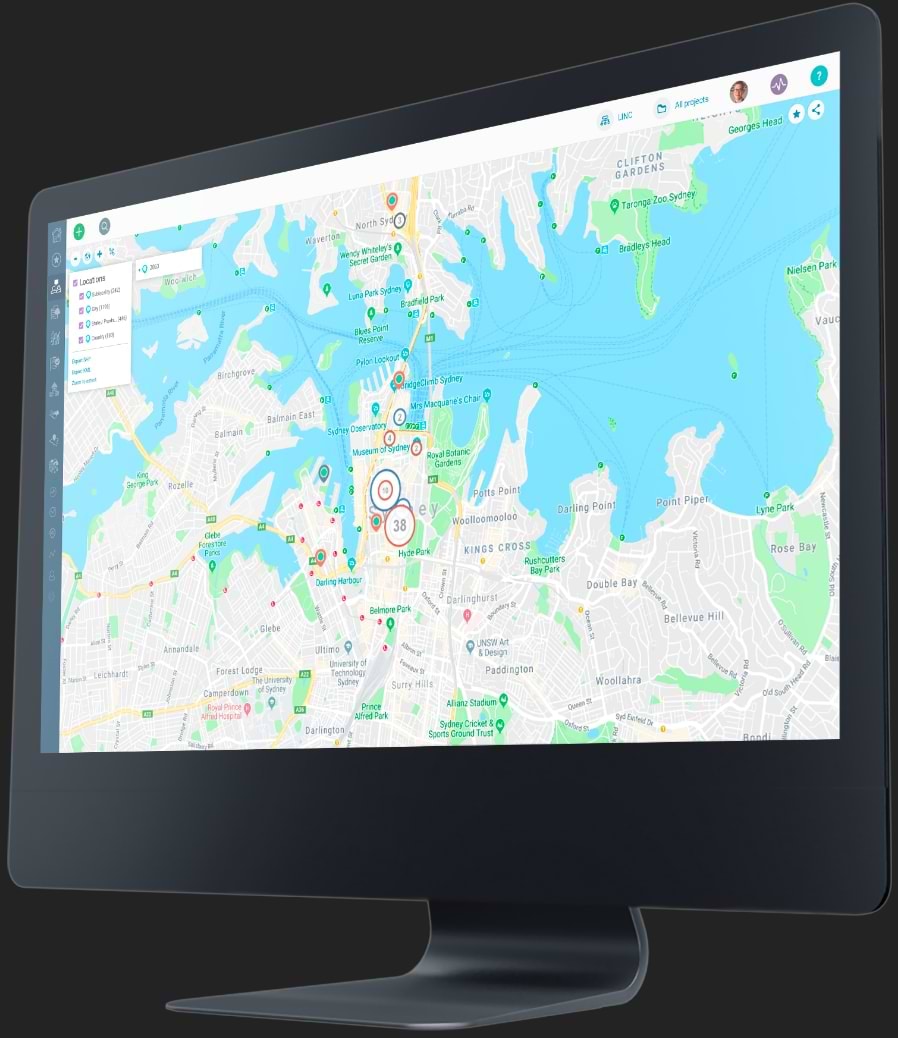Issue and Complaint Management Process
Ensure faster response and closing times for issues and complaints
Implement an automated issue and
complaint resolution process
Efficiently record, assess, and resolve grievances with the Issue and Complaint Management Module. Automate your existing grievance management process based on industry best practices. The systematic, transparent complaint management process in Borealis will help you build trust with local communities and mitigate the social risks to your project’s success.
Record and track issues and complaints
- Promptly acknowledge receipt of all issues and complaints to let stakeholders know you understand their concerns and take them seriously-an essential first step in building trust.
- Configure the module’s core workflow to suit your own business processes. The embedded root-cause analysis tool can help teams identify actions that should be taken to address potential risks.
- Centralize all data related to stakeholder issues and complaints in a single, accessible grievance register to facilitate auditing and reporting.
- Ensure that you’re respecting human rights standards. Provide a channel for whistleblowers to file a grievance or report an issue anonymously and still receive responses from your team. The feedback portal is fully integrated into the module to support your overall process.

- Implement a solid grievance mechanism to help your organisation navigate all steps of the complaint management process including recording, assessment, investigation, resolution, and close-out.
- Investigate the root cause(s) of recurring grievances and any others that may require special attention.
- Geolocate complaints and concerns on a map to see how they relate to project assets and activities. Quickly flag any necessary changes and communicate project-critical information to affected stakeholders to maintain social license to operate.
- Keep stakeholders informed about the status of ongoing issues. Effectively confirm with affected parties that their grievances were resolved in a satisfactory manner. Close any unsubstantiated or fraudulent complaints and document the reasons supporting the decision.
Follow up on commitments
- Track all commitments made to stakeholders, whether they come from formal public statements, informal agreements during a consultation, or negotiations during the grievance resolution process.
- Review any commitments that were made to stakeholders as you engage with them to ensure that promises are kept.

- Analyze, classify, and prioritize issues and complaints based on their potential impact on the project. Identify any necessary actions or commitments that need to be made.
- Report on the number, type, and status of issues or complaints during a given timeframe. Track grievance trends over time along with profiles of the people who submitted them. View this information in a list, or on a map to identify potential hot spots.
- Generate detailed reports in just a few clicks to respond quickly and efficiently to audits.
The benefits of automating your
issue and complaint management process
Your grievance management process is essential for the viability of any project you undertake. Complaints that are not acknowledged can turn into protests, strikes, or, in extreme cases, violent acts. These events can interrupt work and tarnish your company’s reputation, locally and internationally. Automate your complaint management process so issues are dealt with promptly and stakeholders feel that you take their concerns seriously.
Comply With Best Industry Practices
Receiving complaints is part of stakeholder engagement and management. Never hide or ignore grievances. Adhere to international best practices with an issue and complaint management process that allows your stakeholders to file complaints safely, securely, and, if needed, anonymously so you can address them fairly and transparently.
Streamline Workflow
An effective complaint management system helps you efficiently track all stakeholder complaints from the initial issue to resolution. Our software allows you to ensure complaints are dealt with quickly by assigning a task to the appropriate team member who can handle the issue efficiently. Ensure that you avoid facing the same issues and complaints by adding a commitment when you close out a grievance.
Gain Visibility into the Cost of Complaints
Tracking all your complaints in a central location allows you to monitor and calculate the time spent on each step of the complaint management process. Not only will you resolve issues promptly, but you can also track the financial cost of each complaint. You’ll have an accurate view of the compensation paid when resolving grievances. while getting a real-time view of how much time each complaint requires.
Features to help you
standardized your grievance management process
Improve your knowledge of issue and complaint management best practices
Automate your grievance and complaint management process.
Complaint Management Process FAQ
Complaints are a part of business. They can involve a broad spectrum of subjects, questions, or issues and represent minor issues or much more severe conflicts involving acts of violence. Complaints can be expressed in the form of legal claims or protests and can be from individuals or groups.
Complaint management for community issues is part of a process that aims to prevent, mitigate, or resolve tensions and conflicts between companies and local communities. It is an integral part of the International Finance Corporation’s (IFC) approach that requires community engagement under its Social and Environmental Sustainability Policy.
Implementing a stakeholder complaint management process is essential to address concerns and issues raised by stakeholders in a timely and effective manner. It helps maintain relationships with stakeholders and can prevent issues, conflicts, or grievances from escalating, reducing social risk, thus minimizing project disruption or closure or impact on your corporate reputation.
A grievance management process also sends a positive message to local communities, showing them your company recognizes its accountability and assumes responsibility for resolving critical issues. It enables a climate of trust that creates meaningful dialogue, essential elements to obtaining and maintaining the social license to operate.
The IFC provides guidelines for managing complaints, including clearly defined objectives, assigned responsibilities, timelines, a budget, monitoring by senior management, and regular reports. Complaint management software helps automate this process effectively by managing stakeholders’ issues, complaints, or grievances.
Placing your complaint management process in a central system has several benefits that will help ensure that your stakeholder management runs more efficiently and ultimately leads to greater success for your project.
Here are four key benefits of automating the process:
- Consistency: Developing a grievance management process and placing it in a central system ensures that all team members handle complaints similarly. No matter who handles the issue, there is a standardized process and real-time visibility into communication and resolving the issue.
- Transparency: With all the data in one place, there is complete visibility into complaint management. There is no guesswork. Record and track grievances in one location and respond, investigate, and close out in the same software.
- No oversights: When you record a grievance in a central location, there is no chance it will fall through the cracks. Assign team members to a specific complaint or grievance to ensure that it is dealt with promptly.
- Risk reduction: Reduce operational risks, like work stoppages resulting from stakeholder disapproval.
Stakeholders have a significant influence on your project. Sometimes that can include challenging situations like complaints and issues. As a project manager, the success of your project depends on how you manage stakeholders and develop and adhere to a complaint management process.
One way to show that you care about the issues that stakeholders present is to implement a tool that allows you to collect grievances from community members and other stakeholders anonymously. Putting a transparent and systematic complaint management process in place demonstrates to local stakeholders a sense of accountability and a willingness to listen. This alone can help dismantle what’s often a key stumbling block to creating that climate of trust vital to productive community relationships.
















